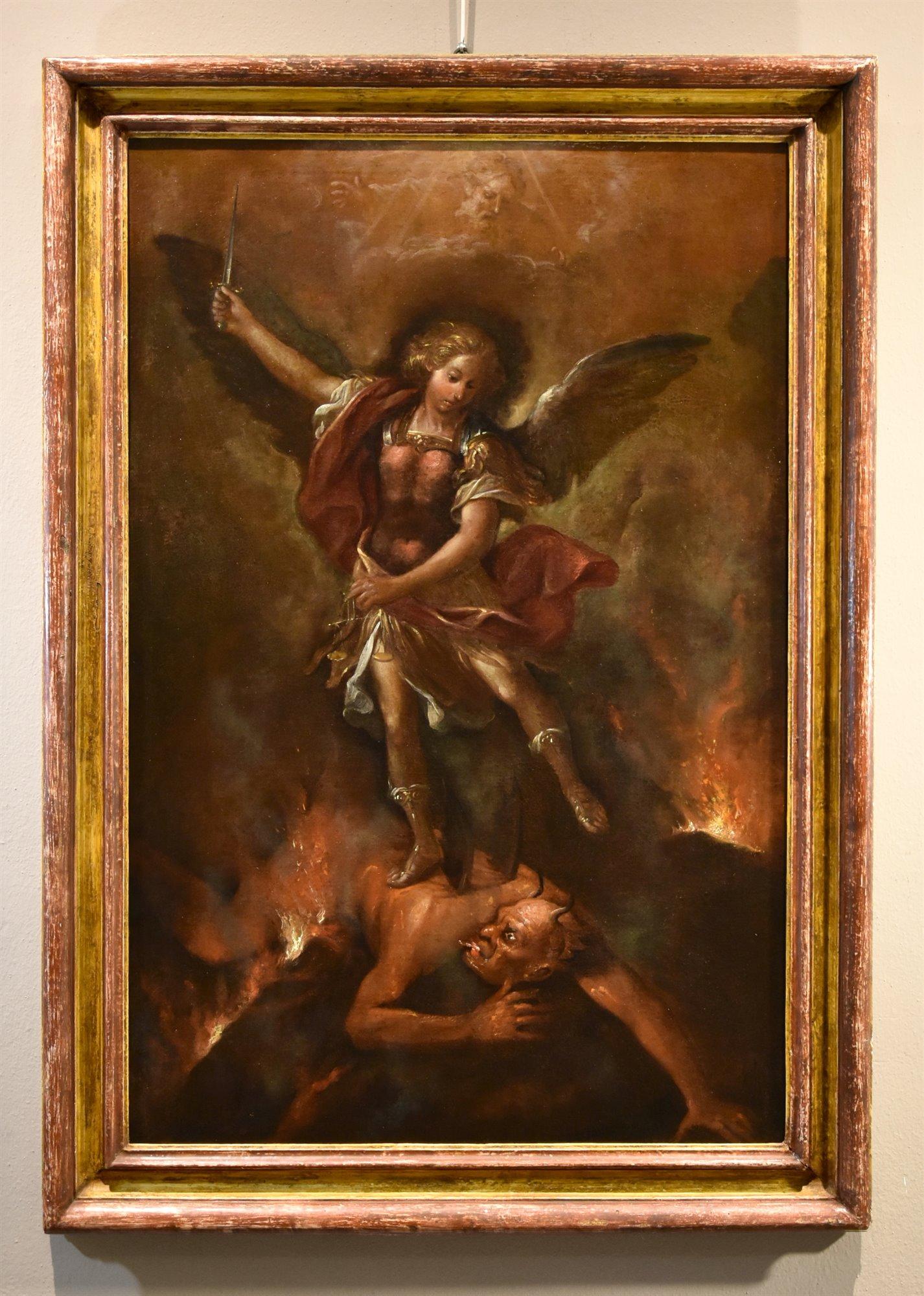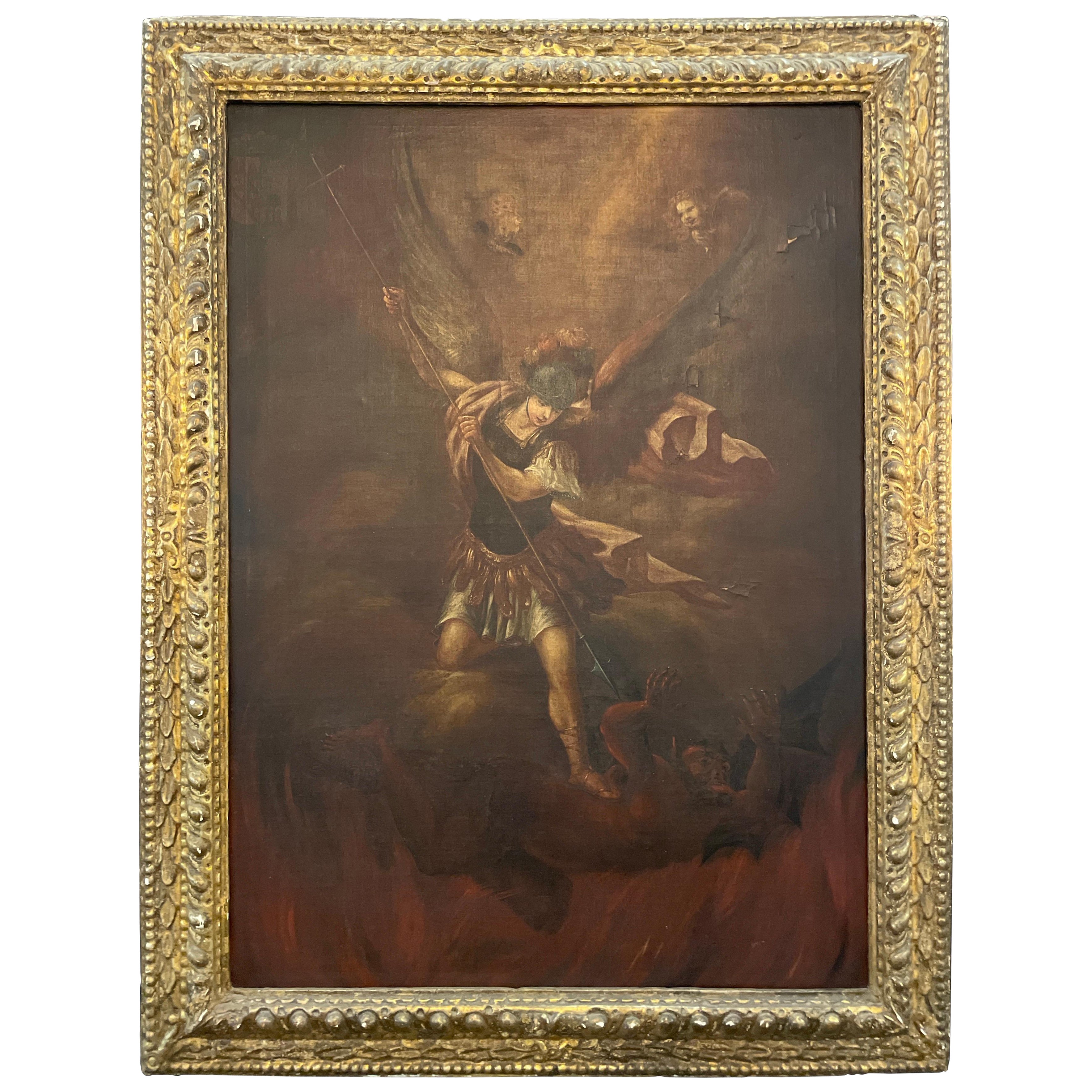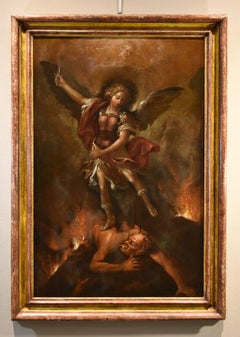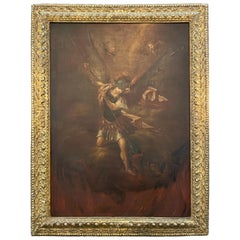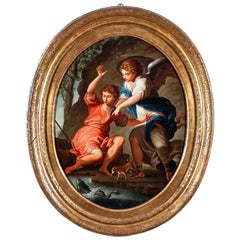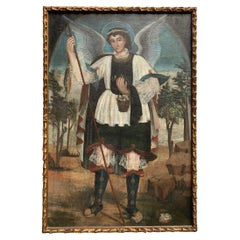Items Similar to Saint Michael Archangel Reni 17/18th Century Paint Oil on canvas Old master Art
Video Loading
Want more images or videos?
Request additional images or videos from the seller
1 of 18
Saint Michael Archangel Reni 17/18th Century Paint Oil on canvas Old master Art1660-1740
1660-1740
$14,796.23
$18,495.2920% Off
£11,073.38
£13,841.7320% Off
€12,480
€15,60020% Off
CA$20,412.69
CA$25,515.8720% Off
A$22,699.76
A$28,374.7020% Off
CHF 11,922.41
CHF 14,903.0120% Off
MX$277,527.36
MX$346,909.2020% Off
NOK 148,564.61
NOK 185,705.7620% Off
SEK 140,056.30
SEK 175,070.3820% Off
DKK 95,003.96
DKK 118,754.9520% Off
About the Item
Saint Michael Archangel
Guido Reni (Bologna 1575 - 1642) Workshop/Follower of
17th-18th century
Oil on canvas (104 x 68 cm. - In frame 109 x 68 cm.)
This high quality painting is based on the famous St. Michael Archangel by Guido Reni, painted in 1635 for the Capuchin Church in Rome (PICTURE 1), erected by donation of Cardinal Antonio Barberini (1569-1646), brother of Urban VIII.
After intensive training in Bologna, 27-year-old Guido Reni travelled to Rome in 1602, soon becoming a celebrated interpreter of the tastes of the most culturally influential circles, and winning the protection of great personalities such as Popes Paul V, Urban VIII and Scipione Borghese.
The Archangel Michael, engaged here in the fight against Evil, is depicted as a young man of rare beauty, strong and delicate at the same time, who, with his sword drawn, repels to hell an irritated devil, whose head he tramples with his foot. The soft draperies envelop the angel's body with an intense classicism, where a balanced composition directs the viewer's attention to his angelic face.
Great was the recognition and esteem of his contemporaries, and the painting was immediately an incredible success, also due to the controversy it aroused on the part of the Pamphili family, a family that had always been in conflict with the Barberini, who commissioned the canvas.
In fact, Reni, having learnt that Cardinal Giovanni Battista Pamphili, the future Pope Innocent X, had slandered him, in revenge impersonated the Devil with his own face.
Guido Reni's cunning was to exploit the historical competition between two of the most influential families in seventeenth-century Rome, the Barberini and the Pamphili, for his own personal revenge, while at the same time giving his work sudden celebrity.
Reni tried his hand at executing this subject on several occasions, much appreciated by his patrons, thanks to the characteristics of formal cleanliness and overall balance of the composition that still make it one of the cornerstones of Roman classicism today.
With the help of his workshop, he used to return to the same subjects several times, producing versions of his most successful compositions, which makes it difficult to disentangle between autograph replicas, workshop works, often enriched by his intervention, and copies that became autonomous re-readings by some of his best pupils.
We can affirm that the proposed canvas is the work of an artist from the workshop or a follower of Reni, painted at a time after his death.
ADDITIONAL INFORMATION:
The painting is sold complete with a gilded frame and comes with a certificate of authenticity and descriptive iconographic card.
We take care of and organise the transport of the purchased works, both for Italy and abroad, through professional and insured carriers.
Should you have the desire to see this or other works in person, we will be happy to welcome you to our new gallery in Riva del Garda, Viale Giuseppe Canella 18. We are waiting for you!
Contact us for any information or to arrange a visit, we will be happy to answer you.
- Creation Year:1660-1740
- Dimensions:Height: 42.92 in (109 cm)Width: 26.78 in (68 cm)
- Medium:
- Movement & Style:
- After:Guido Reni (Bologna 1575 - 1642) (1575 - 1642, Italian)
- Period:
- Condition:
- Gallery Location:Riva del Garda, IT
- Reference Number:1stDibs: LU988115633852
About the Seller
4.9
Platinum Seller
Premium sellers with a 4.7+ rating and 24-hour response times
Established in 2017
1stDibs seller since 2018
258 sales on 1stDibs
Typical response time: <1 hour
- ShippingRetrieving quote...Shipping from: Riva del Garda, Italy
- Return Policy
Authenticity Guarantee
In the unlikely event there’s an issue with an item’s authenticity, contact us within 1 year for a full refund. DetailsMoney-Back Guarantee
If your item is not as described, is damaged in transit, or does not arrive, contact us within 7 days for a full refund. Details24-Hour Cancellation
You have a 24-hour grace period in which to reconsider your purchase, with no questions asked.Vetted Professional Sellers
Our world-class sellers must adhere to strict standards for service and quality, maintaining the integrity of our listings.Price-Match Guarantee
If you find that a seller listed the same item for a lower price elsewhere, we’ll match it.Trusted Global Delivery
Our best-in-class carrier network provides specialized shipping options worldwide, including custom delivery.More From This Seller
View AllSaint Michael Archangel Roman School 17/18th Century Paint Oil on canvas Italy
Located in Riva del Garda, IT
Saint Michael the Archangel Victorious
Roman painter, 17th-18th century
Oil on canvas 112 x 74 cm In frame 128 x 91 cm
This interesting Saint Michael the Archangel subduing ...
Category
17th Century Old Masters Paintings
Materials
Oil
$9,247 Sale Price
20% Off
Saint Michael Archangel 17th Century Paint Oil on canvas Lombard School
Located in Riva del Garda, IT
17th century Lombard painter
Saint Michael Archangel
Oil on canvas
139 x 75 cm. - Framed 156 x 91 cm
Antique painting with St. Michael the Archangel, immortalised full-length as a ...
Category
17th Century Old Masters Paintings
Materials
Oil
$10,603 Sale Price
20% Off
Saint Michael Archangel López 18th Century Paint Oil on canvas Spanish school
Located in Riva del Garda, IT
18th-century Spanish Colonial School
Attributed to Juan Pedro López (Caracas, Venezuela, 1724 - 1787)
Saint Michael the Archangel
Oil on canvas
91 x...
Category
18th Century Old Masters Paintings
Materials
Oil
$8,261 Sale Price
20% Off
Saint Michael Archangel Tuscany school 16th Century Paint Oil on canvas Italy
Located in Riva del Garda, IT
Saint Michael the Archangel victorious over the Devil
Tuscany - 16th century
Oil on canvas
68 x 52 cm. - In frame 97 x 78 cm.
Of great character is this interesting St. Michael the...
Category
16th Century Old Masters Paintings
Materials
Oil
$9,247 Sale Price
20% Off
Announcing Angel Gabriel Maratta 17th Century Paint Oil on canvas Old master
Located in Riva del Garda, IT
The Announcing Angel Carlo Maratta (Camerano, 1625 – Rome, 1713)Workshop
Oil on canvas 63 x 75 cm. - Gilded wood frame 89 x 75 cm.
Excellent condition, restored, 19th century ...
Category
17th Century Old Masters Paintings
Materials
Oil
$9,494 Sale Price
20% Off
Toby Angel Savoldo Religious 17/18th Century Paint Oil on canvas Old master
Located in Riva del Garda, IT
Giovanni Gerolamo Savoldo (Brescia, c. 1480 – after 1548) Follower of
Toby and the Angel
Oil on canvas 63 x 76 cm - In frame 77 x 90 cm
We are pleased to offer this valuable ...
Category
17th Century Old Masters Paintings
Materials
Oil
$6,781 Sale Price
20% Off
You May Also Like
18th Century Spanish Oil Painting On Canvas Of Saint Michael Slaying The Demon
Located in Round Top, TX
Beautifully painted oil on canvas of the Archangel Saint Michael slaying the demon… It’s set in a gold gilt wood carved frame from the same period. Some of the gilded parts show worn...
Category
Antique 18th Century Spanish Paintings
Materials
Canvas, Giltwood
18th Century Italian "Saint Raphael Archangel" Oil on Canvas with Gilded Frame
Located in Marbella, ES
18th century Italian "Saint Raphael the Archangel" oil on canvas with gilded frame.
Category
Antique Mid-18th Century Italian Paintings
Materials
Canvas, Wood
18th-century Spanish Colonial oil on canvas depicting Saint Raphael Archangel
Located in Rio De Janeiro, BR
A monumental and captivating 18th-century Spanish Colonial oil on canvas depicting Saint Raphael the Archangel, rendered in grand scale with overall dimensions of 167 cm height by 11...
Category
Antique Mid-18th Century Spanish Colonial Paintings
Materials
Canvas
The Archangel Gabriel, 19th Century after Guido RENI (1575-1642)
By Guido Reni
Located in Blackwater, GB
The Archangel Gabriel, 19th Century
after Guido RENI (1575-1642)
Huge 19th century Italian Old Master depiction of the Archangel Gabriel, oil on canvas. Excellent quality and cond...
Category
17th Century Portrait Paintings
Materials
Canvas, Oil
$13,629 Sale Price
20% Off
Fine Italian Old Master Oil Painting Angel & Saints Appearing to Figures
Located in Cirencester, Gloucestershire
Artist/ School: Italian Old Master, 18th century
Title: Angel and Saints appearing to figures, one dressed in a white ruff collar.
Medium: oil on canvas...
Category
Early 18th Century Old Masters Figurative Paintings
Materials
Canvas, Oil
17th Century Oil on Canvas Italian Biblical Painting Tobias And The Angel, 1660
Located in Vicoforte, Piedmont
Wonderful 17th century Italian painting. Oil on canvas artwork depicting Tobias and the angel Raphael, a famous biblical episode from the Book of Tobit. In the story, the young Tobia...
Category
Antique 1660s Italian Paintings
Materials
Canvas
More Ways To Browse
Same Old
Oil Paintings 17 Century
Old Man Oil Painting
Master Copy Painting
Man Reading Painting
Saint Michael
Old Master Copies Painting
Devil Painting
17th And 18th Century Oil Paintings
Seventeenth Century Paintings
Italian Oil Painting Old Man
Oil Painting Cardinal
Michael Roman
Antique Replicas
Oil Painting Guido
Guido Reni
Antique Devil
Antique Autographs
